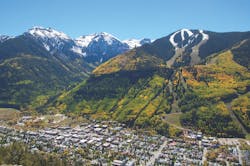Plant Profile: Telluride Regional Wastewater Treatment Plant
About the author:
Cristina Tuser is associate editor for WWD. Tuser can be reached at [email protected].
Surrounded by expansive, rugged peaks and waterfalls, the town of Telluride, Colorado, is home to a population of about 2,473 people. The town is in a small box canyon in Southwest Colorado, located along the San Miguel River.
Known for its all-season resort town, Telluride’s daytime population is somewhere closer to 7,000 and can even eclipse 20,000 during ski and festival seasons. Snowshoes and skis aside, the town is also home to three water treatment plants and one wastewater treatment plant.
Seasonal Flows & Swings
The Telluride Regional Wastewater Treatment Plant (WWTP) serves the region and includes the town of Mountain Village, a ski-area, which owns 35% of the facility. The facility also caters to the wastewater treatment needs of Aldasoro Ranch, Lawson Hill, Hillside Subdivision, Sunset Ridge Subdivision and Eider Creek Subdivision.
Built in 1986, the WWTP is an aerobic secondary treatment facility designed for 2 million gallons of water per day (mgd), but during peak season it treats approximately 1 mgd. For comparison, two other water treatment plants in Telluride, Mill Creek and Pandora WTP, both have capacities of 1 mgd.
Telluride’s Water and Wastewater Division Manager Katie Doody received her environmental engineering degree from the U.S. Military Academy. She came out of the academy as an engineer officer for the Army for six years and wanted to try her hand in the civilian world. She landed a position as division manager for the Telluride Regional WWTP along with the town’s other water facilities.
Doody’s predecessor, Bill Goldsworthy, was water and wastewater superintendent for the town for more than 40 years until 2020 when Doody took over. The facility has a few lab operators with more than 20 years of experience. In total, Telluride WWTP has a team of nine people.
With a busy skiing season in the winter and an energetic festival season in the summer, the spring and fall are the plant’s low seasons.
“That’s actually a challenge of running it,” Doody said. “How do you prepare for an onslaught of bugs or an onslaught
of wastewater?”
Given its location, altitude has an impact on the treatment process for the plant. This presents a number of challenges due to extreme climatic conditions in high altitude regions, including: strong solar radiation, sharp variation in temperature from day to night, rarefied air and low oxygen pressure.
The wastewater treatment process itself is straightforward. From the raw station, the plant pumps up water into the headworks, which flows through the primary clarifiers and from there up to the aerobic ditches. At this point, the water undergoes secondary treatment, ultraviolet (UV) disinfection, and the final effluent discharges into the San Miguel River.
Climate Change & Water Flow
According to data from the Natural Resources Conservation Service of Colorado, Southwestern Colorado faces dry conditions with snowpack measured in the combined San Miguel, Dolores, Animas and San Juan river watersheds at 87% of normal.
“We’re constantly in a drought,” Doody noted about San Miguel County. “Making sure that we have and maintain good water conservation and that we’re doing absolutely everything we can to produce the best effluent to help the rest of the river.”
As Telluride faces cold weather, altitude and a growing population, the treatment facility often questions how a limited amount of space can still create room for upgrades for the plant.
In 2016, the state of Colorado enacted more strict requirements for nutrients and metal limits.
“We needed to start planning our upgrades, because at that time a plant from the ‘80s, even though it runs fine for the regulations we have now, [it] was not identified to maintain with what the state and what EPA wants,” Doody added. “It’s troubleshooting and dealing with old technology while trying to maintain [the plant], because we know that a fix is coming, so how do we deal with emergencies?”
For instance, back in August 2020, there was a lightning strike on the raw lift station at the plant, so the team scrambled to fix it and get new meters. Making sure the team was doing its due diligence for the public and the river were key, while also ensuring the fix for this unexpected issue was economical.
According to Doody, there will be an entire plant upgrade to the Telluride Regional WWTP in the next five years to proactively address infrastructure issues that come with aging equipment. Part of these improvements may include better bar screens for the removal of large objects, such as rags and plastics. There is also potential for membrane bioreactors.
The goal is to have these upgrades completed by 2025 or 2026 at the latest, which also aim to address water efficiency and water recycling opportunities.
